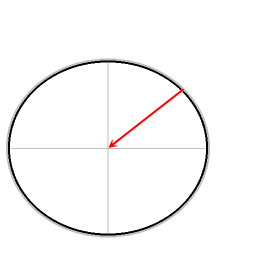تفلطح استوائي
التفلطح الإستوائي Equatorial bulge هو زيادة القطر الاستوائي لجرم كوني نجم أو كوكب سيار على القطر القطبى وذلك نتيجة الدوران المحورى للجرم .
. . . . . . . . . . . . . . . . . . . . . . . . . . . . . . . . . . . . . . . . . . . . . . . . . . . . . . . . . . . . . . . . . . . . . . . . . . . . . . . . . . . . . . . . . . . . . . . . . . . . . . . . . . . . . . . . . . . . . . . . . . . . . . . . . . . . . . . . . . . . . . . . . . . . . . . . . . . . . . . . . . . . . . . .
التفلطح القطبي
التفلطح القطبي هو انبعاج عند القطبين أو تسطح عند قطبي جرم كروي.
الاختلافات في تسارع الجاذبية

The forces at play in the case of a planet with an equatorial bulge due to rotation.
Red arrow: gravity
Green arrow, the normal force
Blue arrow: the resultant force
The resultant force provides required centripetal force. Without this centripetal force frictionless objects would slide towards the equator.
In calculations, when a coordinate system is used that is co-rotating with the Earth, the vector of the fictitious centrifugal force points outward, and is just as large as the vector representing the centripetal force.
Red arrow: gravity
Green arrow, the normal force
Blue arrow: the resultant force
The resultant force provides required centripetal force. Without this centripetal force frictionless objects would slide towards the equator.
In calculations, when a coordinate system is used that is co-rotating with the Earth, the vector of the fictitious centrifugal force points outward, and is just as large as the vector representing the centripetal force.
مدارات الأقمار الصناعية
الأجرام السماوية الأخرى
| Body | Equatorial diameter | Polar diameter | Equatorial bulge | Flattening ratio |
|---|---|---|---|---|
| Earth | 12,756.28 km | 12,713.56 km | 42.72 km | 1:298.2575 |
| Mars | 6,805 km | 6,754.8 km | 50.2 km | 1:135.56 |
| Ceres | 975 km | 909 km | 66 km | 1:14.77 |
| Jupiter | 143,884 km | 133,709 km | 10,175 km | 1:14.14 |
| Saturn | 120,536 km | 108,728 km | 11,808 km | 1:10.21 |
| Uranus | 51,118 km | 49,946 km | 1,172 km | 1:43.62 |
| Neptune | 49,528 km | 48,682 km | 846 km | 1:58.54 |
أنظرأيضا
المصادر
- مؤمن, عبد الأمير (2006). قاموس دار العلم الفلكي. بيروت، لبنان: دار العلم للملايين.
{{cite book}}: Cite has empty unknown parameter:|طبعة أولى coauthors=(help) - Solar System Formation, Accretion, and the Early Thermal State of the Earth
(PDF-file, 312 KB) Available as part of the MIT OpenCourseWare initiative
